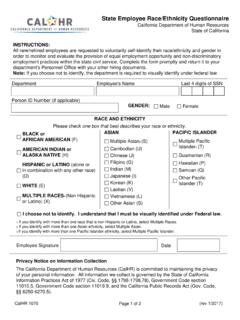Transcription of Infants and Toddlers, Culture, Race and Ethnicity ...
1 Infants and Toddlers, Culture, Race and Ethnicity : References for Course Developers 2015 Kelley Perkins, Infants & TODDLERS, CULTURE RACE & Ethnicity i | Contents Introduction1 .. Know-See-Do-Improve Framework1 .. Quick Reference Table .. 4 Cultural Competency .. 7 Forming Relationships .. 7 Culture in Classrooms .. 9 Culture and Caregiving ..10 Culture, Race, Learning and Development ..10 ECE, Race and Culture ..12 Books ..13 Additional Internet Resources.
2 14 About the Author ..14 Note: This paper was created through Early Educator Central, a web portal federally administered by the Department of Health and Human Services, Office of Child care and Office of Head Start, in response to the need for relevant resources to enhance infant-toddler content and coursework. ICF served as the contractor under Contract #HHSP23320095636WC_HHSP2337034T with the Department of Health and Human Services. The views expressed in the document are those of the author and ICF. No official endorsement by the Department of Health and Human Services is intended or should be inferred.
3 Infants & TODDLERS, CULTURE, RACE AND Ethnicity 1 | Introduction The following resource is designed to help higher education faculty who are creating infant-toddler coursework for non-traditional students and are seeking materials related to culture, race and Ethnicity . Following a brief explanation of the Know-See-Do-Improve framework, this document provides a table for all references, followed by summaries of articles and a listing of books that include content about culture, race, and Infants -toddlers.
4 This is not an exhaustive list of references, but a guide to help think about what content to include when designing coursework. The articles are organized by the content areas found in the 2010 NAEYC Standards for Initial & Advanced Early Childhood Professional Preparation Programs. Overview of NAEYC Content Areas Content Area NAEYC Standard Focus Cultural Competency 2a Knowing and understanding diverse family and community characteristics Forming Relationships 2a & 4a Knowing and understanding diverse family and community characteristics.
5 Understanding positive relationships and supportive interactions as the foundation of their work with children Culture in Classrooms 2c Involving families and communities in their children s development and learning Culture and Caregiving 1b & 2a Knowing and understanding the multiple influences on development and learning. Knowing and understanding diverse family and community characteristics Culture, Race, Learning and Development 1b Knowing and understanding the multiple influences on development and learning ECE, Race and Culture 2a Knowing and understanding diverse family and community characteristics Know-See-Do-Improve Framework The Know-See-Do-Improve Framework used by Early Educator Central helps guide course designers to ensure elements of the course include not just content (know)
6 But also the important opportunities to see examples of competencies, to do or practice new skills and to then improve through reflective activities. This document focuses on the first element of the framework, with a rationale provided for why course developers should also include opportunities and integration of the other elements of the framework, see-do-improve. 2 | Know Content that aligns with the National Association for the Education of Young Children Standards for Early Childhood Professional Preparation, Head Start and Early Head Start Relationship-Based Competencies, CDA Competency Standards and state core knowledge and competencies can promote a seamless career pathway from state to state and within states across sectors (portable) for the infant toddler Aligning with NAEYC standards is also a useful strategy to promote articulation.
7 See Content that includes field-based or web-mediated examples of competency promotes the link between course content and a course participant s ability to understand what that competency looks like in a setting similar to their Do Infant toddler professional development that provides an opportunity to apply knowledge in work/practicum settings allows caregivers to practice what they have learned and to reflect on their own demonstration of Suggestions for this area of the framework include opportunities for teachers to video their own practice and then to have the instructor provide coaching to enhance the teacher s practice.
8 This includes designing course activities that include time for planning the integration technology as appropriate and also practicing working with families with technology. Early Educator Central provides The Coaching Companion as an open-source online digital observation tool to aid in this process. Improve Infant toddler professional development that includes self-reflection and assessment by a professional who uses an evidence-based tool provides the necessary components for competency-based learning and The final step in the framework provides an opportunity for caregivers to submit a new demonstration (self-selected exemplar)
9 And reflect on 1 Department of Education, Office of Planning, Evaluation and Policy Development, Policy and Program Studies Service. (2010). Toward the identification of features of effective professional development for early childhood educators: Literature review. Retrieved from ; NAEYC. (2009). NAEYC Standards for early childhood professional preparation. Retrieved from 2 Hamre, , Pianta, , Burchinal, M., Field, S., LoCasale-Crouch, J., Downer, , C.
10 (2012). A course on effective teacher-child interactions: Effects on teacher beliefs, knowledge, and observed practice. American Educational Research Journal, 49(1), 88-123. ; Joseph, G. & Brennan, C. (2013). Framing quality: Annotated video-based portfolios of classroom practice by pre-service teachers. Early Childhood Education Journal, 41(6), 423-430; Pianta, R. C., Mashburn, A. J., Downer, J., Hamre, B. K. & Justice, L. (2008). Effects of web-mediated professional development resources on teacher-child interactions in pre-kindergarten classrooms.










